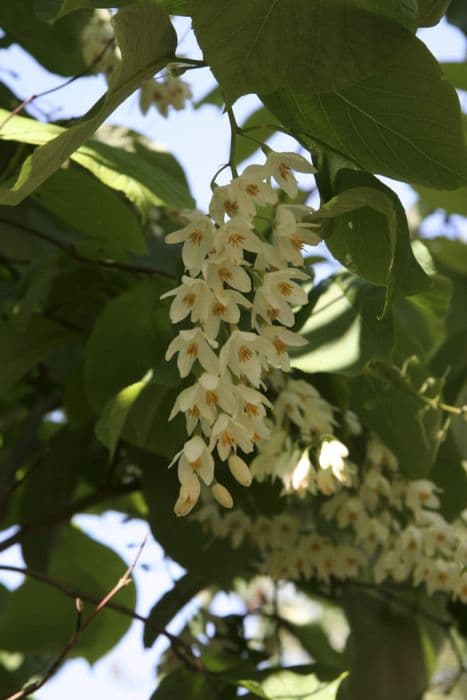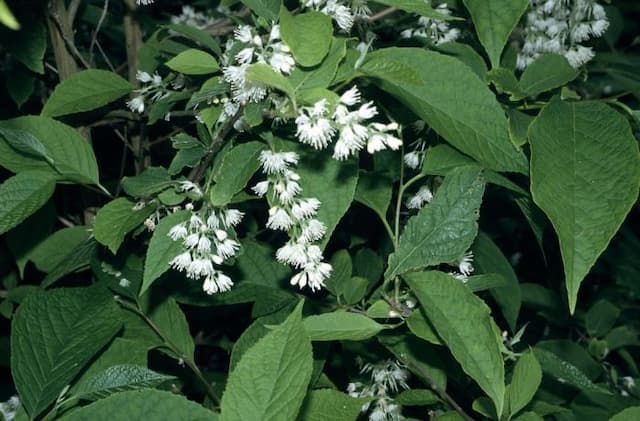Japanese Snowbell Styrax japonicus 'Fargesii'

ABOUT
The Japanese Snowbell 'Fargesii' variety is an enchanting flowering tree known for its elegant form and ornamental features. It has a beautiful, rounded crown adorned with ovate to oblong, pointed leaves that are a lush, glossy green. In the spring and early summer, this tree is a sight to behold when it blooms with an abundance of bell-shaped, fragrant white flowers. These delightful blossoms dangle gracefully from the branches, creating a soft, snow-like effect. Each flower is a delicate work of nature with subtly textured petals, and as they age, they may develop a faint pinkish hue. These are followed by small, rounded fruits that attract birds and other wildlife. In the fall, the foliage transforms into shades of yellow and sometimes purple, adding a warm touch to the cooling landscape. The bark of the Japanese Snowbell 'Fargesii' is smooth and gray, providing a striking contrast to the green leaves and a unique visual interest in the winter garden when the leaves have fallen. Throughout the seasons, this tree presents a soothing, picturesque presence that is both refined and enchanting.
About this plant
 Names
NamesFamily
Styracaceae
Synonyms
Farges' Snowbell, Farges Styrax
Common names
Styrax japonicus 'Fargesii'.
 Toxicity
ToxicityTo humans
The Japanese Snowbell, as Styrax japonicus 'Fargesii' is commonly known, is not typically regarded as a poisonous plant to humans. It does not have a reputation for causing serious harm if ingested. That being said, consuming any plant material might cause discomfort, and individual allergies or sensitivities could potentially result in mild gastrointestinal upset or irritation. It is always best to avoid eating parts of ornamental plants due to the unpredictability of individual reactions.
To pets
The Japanese Snowbell is not recognized for being toxic to pets, including dogs and cats. It is generally considered safe and does not appear on common lists of plants that are poisonous to domestic animals. Even so, ingestion of non-food items can cause pets to experience gastrointestinal discomfort. It's advisable to prevent pets from consuming plant material to avoid any potential issues such as vomiting or diarrhea, which, while not specific to toxicity, can occur from eating plants not meant for consumption.
 Characteristics
CharacteristicsLife cycle
Perennials
Foliage type
Deciduous
Color of leaves
Green
Flower color
White
Height
20-35 feet (6-10 meters)
Spread
20-35 feet (6-10 meters)
Plant type
Tree
Hardiness zones
5-8
Native area
China
Benefits
 General Benefits
General Benefits- Ornamental Value: Styrax japonicus 'Fargesii', commonly known as Japanese Snowbell, has an elegant branching structure and a showy floral display which adds ornamental value to gardens.
- Shade Provider: With its canopy of leaves, the Japanese Snowbell offers a cool, shaded area beneath it during hot summer months.
- Attracts Wildlife: The tree’s fragrant flowers attract a variety of pollinators, including bees and butterflies, which can contribute to the pollination of nearby plants.
- Low Maintenance: Japanese Snowbell is considered to be a low maintenance tree, requiring minimal pruning and care once established in an appropriate location.
- Compact Size: Reaching only moderate heights, it is well-suited for smaller gardens or urban landscapes where space is limited.
- Improves Biodiversity: By providing habitat and food for wildlife, it helps to enhance local biodiversity.
- Seasonal Interest: Throughout the seasons, it offers visual interest from spring blooms to autumn leaf color and an elegant winter silhouette.
- Drought Tolerance: Once established, it has a degree of drought tolerance, making it suitable for gardens in drier climates.
 Medical Properties
Medical PropertiesThis plant is not used for medical purposes.
 Air-purifying Qualities
Air-purifying QualitiesThis plant is not specifically known for air purifying qualities.
 Other Uses
Other Uses- Jewelry: The hard seeds of the Japanese Snowbell can be polished and used to make beads for necklaces and bracelets.
- Art Supplies: Twigs and branches can be harvested and carved into tools like styluses or even pen nibs for calligraphy.
- Photography: As an ornamental plant with delicate white flowers, it can be used as a subject for botanical photography and visual arts.
- Educational Model: Botany educators can use the plant to show the structure of a flowering plant and the process of pollination to students.
- Wood Crafting: The wood is fine-grained and can be used in making small wooden objects such as boxes or intricate carvings.
- Sound Amplification: The wood has properties that can be utilized in the creation of certain musical instruments or parts of them, such as a flute or a guitar body.
- Floristry: Branches with flowers and leaves can be used as part of floral arrangements or bouquets because of their aesthetic appeal.
- Decoration: Dried flowers and seed capsules of the Japanese Snowbell can be used for decorative purposes in potpourri or as a natural ornament during the holiday season.
- Scented Garden Element: The flowers emit a light, pleasant fragrance that can contribute to a scented garden or outdoor space designed for aromatherapy.
- Culinary Decoration: While not commonly used for consumption, the flowers could potentially be crystallized for use as edible decorations on cakes and pastries.
Interesting Facts
 Feng Shui
Feng ShuiThe Japanese Snowbell is not used in Feng Shui practice.
 Zodiac Sign Compitability
Zodiac Sign CompitabilityThe Japanese Snowbell is not used in astrology practice.
 Plant Symbolism
Plant Symbolism- Purity: The white, bell-shaped flowers of the Japanese Snowbell often symbolize purity and innocence.
- Gracefulness: With its elegant, drooping branches and dainty flowers, the Japanese Snowbell is often associated with grace and delicate beauty.
- Peace: The tree's serene appearance and the gentle sway of its flowers in the breeze can symbolize peace and tranquility.
- New Beginnings: The Japanese Snowbell blooms in the late spring, a time often associated with rebirth and new beginnings.
- Perseverance: The Japanese Snowbell is known for its hardiness and ability to thrive in various conditions, symbolizing perseverance and adaptability.
 Water
WaterThe Japanese Snowbell should be watered deeply and thoroughly, allowing the soil to partially dry between waterings. In general, aim to provide about 1 inch of water weekly, which translates to roughly 0.6 gallons for a small shrub. During hot or dry spells, increase the frequency to ensure the soil doesn't completely dry out. However, be cautious not to overwater as this can lead to root rot. Seasonal changes will affect the plant's water needs, with less required in the winter and more in the growing season.
 Light
LightThe Japanese Snowbell thrives in full sun to partial shade. For optimal growth, plant it in a location where it receives morning sun and afternoon shade, protecting it from the harsh midday sun. Too much shade can lead to fewer blooms and a leggy growth habit, while too much direct sun can stress the plant, especially in the hotter zones.
 Temperature
TemperatureThe Japanese Snowbell prefers temperate conditions and can typically handle temperatures down to about 20 degrees Fahrenheit but should be protected from prolonged exposure to these extreme lows. The ideal growing temperatures range from 60 to 75 degrees Fahrenheit. They can tolerate summers up to about 90 degrees Fahrenheit but will require additional watering to cope with the heat.
 Pruning
PruningPrune the Japanese Snowbell to maintain shape and remove any damaged or diseased branches. The best time for pruning is in late winter or early spring before new growth starts. Light pruning can be done throughout the growing season to remove any undesirable branches. Prune sparingly, as heavy pruning can reduce the number of flowers.
 Cleaning
CleaningAs needed
 Soil
SoilJapanese Snowbell thrives in a well-draining soil mix with a slightly acidic pH of 5.5 to 6.5. A blend of loamy soil, compost, and sharply-drained sand or perlite creates an ideal environment for root growth and health. Regularly check for soil compaction and ensure adequate nutrient content for optimal growth.
 Repotting
RepottingJapanese Snowbell does not require frequent repotting; it should be done every 3-5 years. Repotting is best done in late winter or early spring before new growth begins. Choose a container only slightly larger than the previous one to avoid over-potting, which can lead to water-logged roots.
 Humidity & Misting
Humidity & MistingJapanese Snowbell prefers moderate humidity levels, ideally between 40-60%. While it can tolerate some dryness, maintaining consistent humidity will promote healthier leaves and flowers. Avoid placing it in extremely dry environments as it could stress the plant.
 Suitable locations
Suitable locationsIndoor
Provide bright, indirect light and keep the soil moist.
Outdoor
Plant in partial shade with moist, well-draining soil.
Hardiness zone
5-8 USDA
 Life cycle
Life cycleStyrax japonicus 'Fargesii', commonly known as the Japanese Snowbell, begins its life cycle as a seed that requires a period of cold stratification to break dormancy. Upon germination in spring, the seedling will emerge and, if conditions are favorable (well-draining soil, adequate moisture, and light), will establish a root system and send up shoots. As the plant grows through the vegetative stage, it develops a branching habit with leaves unfurling, capturing sunlight for photosynthesis. After a few years, when the tree matures, it will start to flower in late spring to early summer, producing fragrant white bell-shaped flowers that attract pollinators. Following pollination, the Japanese Snowbell produces drupes (fruit) that mature by late summer or early fall, which are dispersed by gravity or animal activity to begin new plants. The Japanese Snowbell is deciduous, losing its leaves in autumn to conserve energy through the winter, completing its annual growth cycle.
 Propogation
PropogationPropogation time
Spring-Early Summer
The Japanese Snowbell 'Fargesii' is commonly propagated by softwood cuttings. The optimal time to take these cuttings is in late spring or early summer, when the new growth is still flexible but has begun to mature slightly. To do this, select a healthy branch and cut a piece that is about 6 inches (approximately 15 centimeters) long, making sure there are at least two to three sets of leaves. The lower leaves should be removed, and the cut end dipped in rooting hormone to encourage root development. This treated end is then inserted into a well-draining soil mix. The cutting should be kept in a humid environment with consistent moisture and indirect light until roots have formed, which can take several weeks. Once established, the cutting can be transplanted to a more permanent location.



![Japanese snowbell [Marley's Pink Parasol]](/_next/image?url=https%3A%2F%2Fplants-admin.emdemapps.com%2Fimages%2Fplants%2F%2Fimages%2F604b602fef992.png&w=640&q=75)
